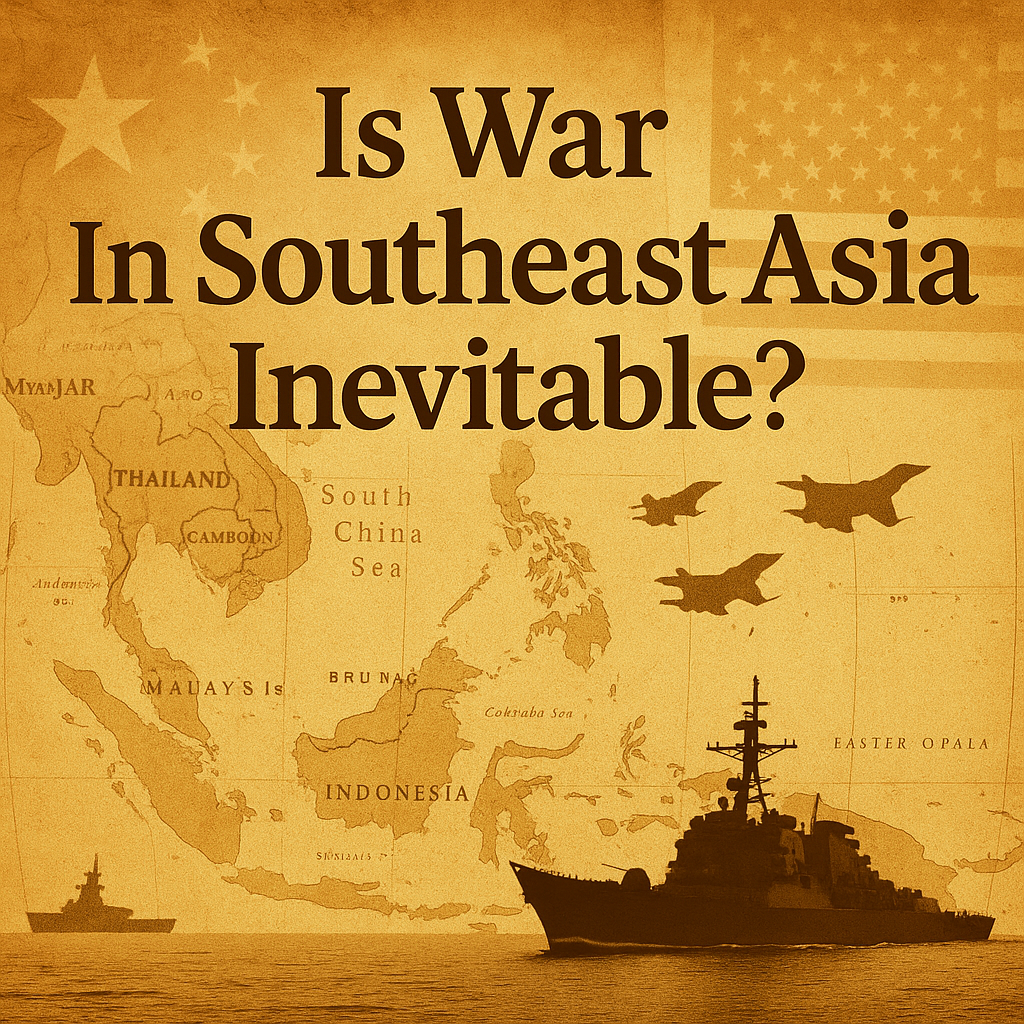Your cart is currently empty!

Is War in Southeast Asia Inevitable? Geopolitics, History, and Rising Tensions
Introduction: Between Hope and History
Is war in Southeast Asia inevitable? This question lingers in the minds of scholars, diplomats, and citizens alike. The region’s history offers little reassurance. From the mighty Srivijaya and Majapahit kingdoms that clashed over trade routes, to the colonial conflicts that reshaped borders, Southeast Asia has always been vulnerable to violence. In the 20th century, the Malayan Emergency and the Vietnam War left scars that remain part of the political consciousness today. The region has never truly been free of conflict, only periods of fragile calm.
At the same time, Southeast Asia is home to a modern story of hope. Since the late 20th century, ASEAN has championed cooperation, turning former rivals into partners and pushing for integration. Economic growth, tourism, and global trade routes have raised living standards and linked the region to the world economy. For many, this is proof that Southeast Asia can finally leave its violent past behind.
But the rise of China and India, combined with the enduring presence of the United States, means the region is again a stage for great-power competition. The South China Sea disputes, the Sino-Indian border standoff, and U.S. freedom of navigation patrols remind us that tensions remain close to the surface. History and geopolitics intersect in dangerous ways, raising the question of whether hope or history will define the next chapter.
Ultimately, Southeast Asia stands at a crossroads. Its nations are more connected and prosperous than ever, yet the shadows of power rivalry and territorial disputes make it one of the most volatile regions on earth. The coming decade will determine if this fragile peace can hold.
The Players: Who Could Be Drawn Into a Southeast Asia War?
Any serious discussion about a possible Southeast Asia war must begin with identifying the main players. China and India are the obvious contenders. Both are rising Asian powers, both see themselves as natural leaders, and both are unwilling to concede influence to the other. A clash between them is no longer unthinkable, and Southeast Asia could be the battleground.
Yet, a war in Southeast Asia would not remain bilateral. The United States, with its Indo-Pacific strategy and military alliances, would inevitably be drawn in. Washington’s security treaties with the Philippines and its strategic partnership with Singapore make it a stakeholder in any conflict. The principle of preventing regional hegemony also means the U.S. cannot afford to let either Beijing or New Delhi dominate Southeast Asia.
For smaller ASEAN nations, the dilemma is profound. Countries like Vietnam, Malaysia, and the Philippines might side with the U.S. to balance against China. Others, like Cambodia or Laos, more dependent on Beijing’s investments, may tilt toward China. Meanwhile, Indonesia, as ASEAN’s heavyweight, would face immense pressure to abandon neutrality. In short, any war in Southeast Asia would quickly become a multi-layered conflict involving not only the giants but also smaller states forced to choose sides.
The balance of power in Southeast Asia is fragile precisely because the players are interconnected. Trade ties, security commitments, and cultural links create overlapping loyalties, making neutrality almost impossible. Once the first shot is fired, the dominoes could fall quickly.
Why Would a War Break Out?
The reasons for war in Southeast Asia are visible in the open. The most obvious is territorial disputes. The South China Sea remains the primary flashpoint, with China’s expansive nine-dash line claim clashing with Vietnam, the Philippines, Malaysia, and Brunei. The Spratly and Paracel Islands are militarized, and incidents involving fishing boats and naval patrols are frequent. Any miscalculation could spiral into confrontation.
Beyond the South China Sea, the Indian Ocean hosts its own tensions. India and China both eye strategic islands such as the Andaman and Nicobar, critical for controlling sea lanes. Meanwhile, the Himalayan frontier between India and China has seen deadly clashes, showing that even high-altitude borders are potential triggers for wider war.
At the heart of these disputes lies the deeper question of hegemony. China sees Southeast Asia as its natural sphere of influence, backed by economic clout and naval power. India, with its demographic surge and “Act East” policy, is determined to assert its presence. For ASEAN states, this contest feels like a tug-of-war where their sovereignty and autonomy hang in the balance.
Finally, nationalism adds fuel to the fire. Rising nationalist rhetoric in Beijing, New Delhi, and even Southeast Asian capitals makes compromise harder. Leaders know that public opinion rewards defiance, not concession. This makes the possibility of de-escalation more uncertain.
How Could a Southeast Asian War Start?
Predicting the precise spark of a Southeast Asian war is impossible, but experts outline several likely scenarios. One is a sudden Chinese strike on Singapore, which hosts U.S. naval facilities. Such a move would cripple Washington’s regional presence, humiliate a symbol of Southeast Asian prosperity, and send a warning to neighboring states. Singapore’s geographic position at the crossroads of the Malacca Strait makes it a strategic prize.
Another potential trigger lies in the South China Sea. A collision between Chinese and U.S. warships during freedom of navigation operations could escalate into armed conflict. The presence of militarized artificial islands, advanced radar systems, and naval patrols makes the waters dangerously crowded. One miscalculation or aggressive maneuver could ignite a crisis.
A third scenario stems from the Himalayan frontier. If China and India clash again along their contested border, both might extend the conflict into Southeast Asia by targeting each other’s regional allies. This would pull in ASEAN states, whether they wished it or not.
Each of these scenarios demonstrates the fragility of peace. The interconnected geography of Southeast Asia means that once conflict starts, it will not remain contained. The entire region would be pulled into the vortex, with global powers choosing sides.
The South China Sea: The Flashpoint of Global Trade
The South China Sea is not just a regional issue; it is a global artery. More than one-third of global trade, including vital oil and gas shipments, passes through its waters. Any disruption here would send shockwaves across the global economy, raising shipping costs, increasing oil prices, and threatening supply chains.
For China, the South China Sea is central to its maritime ambitions. By building artificial islands and deploying military bases, Beijing asserts control over one of the busiest waterways in the world. For the U.S., ensuring freedom of navigation is a strategic imperative. Neither side can afford to back down, which makes confrontation increasingly likely.
ASEAN nations are caught in the middle. Vietnam has fiercely resisted Chinese encroachment, while the Philippines alternates between seeking U.S. protection and pursuing bilateral talks with Beijing. Malaysia and Brunei quietly assert claims, while Indonesia defends its Natuna waters. Each has different stakes, but none can ignore the consequences of escalation.
If war erupts in the South China Sea, the costs will be staggering. It will not only devastate the economies of Southeast Asia but also destabilize global markets. This is why many analysts call it the most dangerous flashpoint in Asia, comparable to the Taiwan Strait or the Korean Peninsula.
Indonesia and the Balance of Power
Indonesia occupies a unique position in Southeast Asia’s security landscape. As the largest nation in ASEAN and the guardian of the Malacca Strait, it holds strategic weight. Historically, Jakarta has embraced a policy of non-alignment, preferring to balance ties with both Washington and Beijing. However, Chinese incursions into the Natuna waters and rising Indo-Pacific tensions have tested this stance.
Indonesia’s military is not the strongest in Asia, but its geographic position makes it indispensable. Any war in Southeast Asia would inevitably involve Indonesian waters and airspace. Controlling the Malacca Strait, one of the world’s busiest shipping routes, would be a critical objective for all major powers. This gives Jakarta leverage, but also makes it vulnerable.
Politically, Indonesia faces internal challenges that may complicate its role. Domestic priorities, democratic transitions, and economic growth often compete with defense imperatives. Yet, in times of crisis, Indonesia is expected to take a leadership role in ASEAN, shaping the bloc’s collective response.
If war breaks out, Indonesia’s decisions could tip the balance. Whether it sides with the U.S., leans toward China, or tries to remain neutral, Jakarta’s actions will determine ASEAN’s ability to act as a united front.
China, India, and the United States: The Great Power Triangle
At the core of Southeast Asia’s uncertainty lies the triangular rivalry between China, India, and the U.S. Each has different motivations but overlapping ambitions, creating a dangerous strategic geometry. China seeks maritime dominance, India seeks recognition as a regional counterweight, and the U.S. seeks to preserve the balance of power.
For China, the South China Sea and Indian Ocean are lifelines for its Belt and Road Initiative. Beijing cannot tolerate challenges to its supply routes or its claims of sovereignty. For India, Southeast Asia represents both an opportunity and a battleground. New Delhi’s “Act East” strategy aims to deepen ties with ASEAN and counterbalance Beijing’s influence.
The United States, though geographically distant, remains central to Southeast Asia’s security. Its network of alliances and its Indo-Pacific Command anchor its presence. Washington views the region as critical to preventing Chinese hegemony and maintaining open sea lanes.
This triangle creates instability because each fears encirclement. China worries about U.S. bases and Indian partnerships. India fears Chinese encroachment and U.S. unpredictability. The U.S. fears being pushed out by a Beijing-dominated Asia. For Southeast Asia, this triangle is both a shield and a trap.
Conclusion: The Fragile Peace Ahead
War in Southeast Asia is not inevitable, but it is a very real possibility. The historical legacies of conflict, unresolved territorial disputes, and rising nationalism make the region a volatile flashpoint. The South China Sea, in particular, embodies the intersection of local rivalries and global stakes.
Yet, Southeast Asia also has mechanisms for peace. ASEAN diplomacy, economic interdependence, and a shared interest in stability act as brakes on escalation. The challenge is whether these brakes will be strong enough when great-power rivalry intensifies.
For the region’s citizens, the hope is that leaders will choose cooperation over confrontation. But the structural forces at play—China’s rise, India’s ambitions, and America’s balancing act—make peace fragile. The next decade will be decisive in determining whether Southeast Asia remains a hub of prosperity or becomes the frontline of a new great-power war.


Leave a Reply